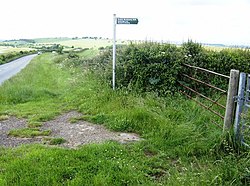Nunwell
| Nunwell | |
| Hampshire | |
|---|---|
 A bridleway in Nunwell | |
| Location | |
| Island: | Isle of Wight |
| Grid reference: | SZ594874 |
| Location: | 50°41’2"N, 1°9’38"W |
| Data | |
| Postcode: | PO36 |
| Local Government | |
| Council: | Isle of Wight |
| Parliamentary constituency: |
Isle of Wight |
Nunwell is the location of Nunwell House, to the west of Brading on the Isle of Wight, Hampshire. This estate was the home of the Oglander family for many centuries. The present family are not direct descendants through the male line and thus the baronetcy has died out.
This is a rural parish of fields and woods, with Nunwell House shaping much of the landscape, all below Nunwell Down rising above, to the south. The house is surrounded by five gardens and also a lily pond.[1] The house also has a ballroom built in 1906, and a dining room from 1896.
History
The Oglander family ruled Nunwell between 1193 and 1204. In 1552 it was purchased by Oliver Oglander.[2]
The Nunwell Estate was owned by Tostig Godwinsson prior to the Norman Conquest. The present house is largely Jacobean and was sold off briefly, with the Oglander family moving into the former coach house.
The mediæval 'Brading Town Gunne' is at the coach house: it was stolen in the 1950s, and rediscovered in a saleroom. It was returned not to the town 'gunne room' but to Nunwell by an anonymous well-wisher. The Town Trust are negotiating for its return. It is cracked due to its having been overcharged to celebrate the 1832 Reform Act.
After King Charles I escaped London, he sailed for the Isle of Wight hoping for a friendly reception, and came to Nunwell. However, the King was seized and taken to imprisonment in Carisbrooke Castle to await his fate.[3]
References
- ↑ "Nunwell House and Gardens, Brading, Isle of Wight" (in en-GB). https://www.isleofwight.com/listing/nunwell-house-and-gardens-brading-isle-of-wight/.
- ↑ National Heritage List 1000928: Nunwell (Register of Historic Parks and Gardens)
- ↑ Nunwell House and Gardens: Red Funnel